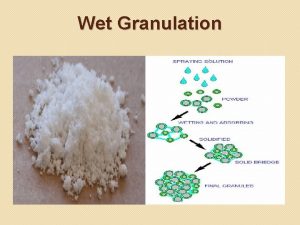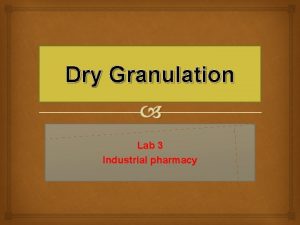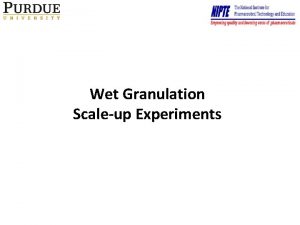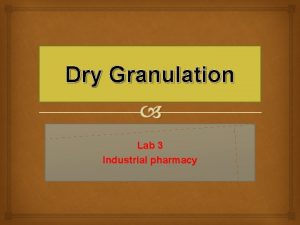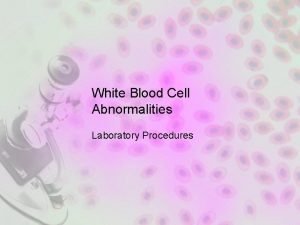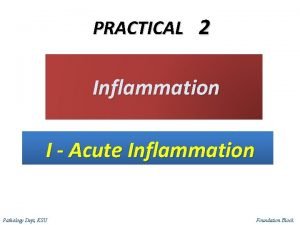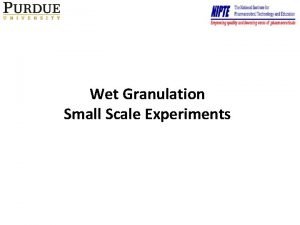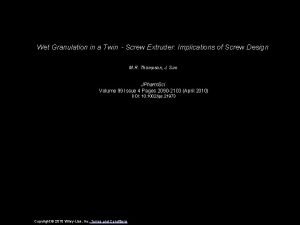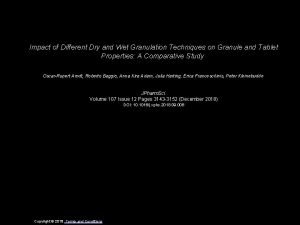Wet Granulation Scaleup Experiments Design of Scaleup Experiments









- Slides: 9

Wet Granulation Scale-up Experiments

Design of Scale-up Experiments Optimum conditions from Duquesne University Wet Granulation experiments: Liquid content : 5 % Liquid addition rate : 15 ml/min Impeller Speed : 500 rpm Wet massing time : 30 sec The liquid percentage is kept same as the smallest scale experiments. The sensitivity to liquid amount is tested around the optimum liquid level that was obtained at small scale. 2

Design of Scale-up Experiments • Ratio of fill height to granulator diameter at all scales should be kept constant. Granulator size Granulation Batch Size (kg) Diameter of the granulator bowl (cm) Fill height / Diameter 4 l 0. 6 17 10 l 1 24. 6 75 l 9. 72 52. 5 0. 27 0. 15 3

Design of Scale-up Experiments • The spraying time and the dimensionless spray flux need to be kept constant. 4 l = 0. 11 For constant spraying time, the values for larger scales with single nozzle are calculated assuming 100 m drop size: 10 l = 0. 15 and 0. 18 (Close to small scale) 75 l = 0. 34 and 0. 50 (Too high compare to small scale, therefore higher amounts of lumps should be expected. Can be 4 lowered by using two nozzles)

Design of Scale-up Experiments • Impeller speed was scaled according to constant tip speed and constant Froude number (Fr) rules (provided that the impeller speed is above the critical Froude number for constant tip speed rule. Constant Fr: Constant tip speed: N: Impeller speed D: Impeller diameter 4 l 10 l ed 500 rpm spe p i t. const. Fr 75 l 340 rpm 420 rpm ed spe p i t. nst 195 rpm const. 290 rpm co Fr 5

Intermediate Scale (10 l) Batch 96251 -1 96251 -2 96251 -3 96251 -4 96251 -5 96251 -6 96251 -7 96251 -8 96251 -9 96251 -10 96251 -11 96251 -12 96251 -13 96251 -14 96251 -15 Impeller Liquid Content (% Liquid Wet Speed of liquid amount Addition Rate addition Massing (rpm) to solid amount) (g/min) time (sec) Time (sec) 420 420 340 420 420 420 6 5 3 4 4 5 5 5 5 28. 5 249. 6 28. 5 28. 5 126 105 63 84 84 10 10 105 105 30 30 60 0 30 30 30 a Median Particle Size (µm) % of lumps (> 1 mm) 0. 15 0. 18 0. 15 0. 15 280 175 220 201 207 212 286 275 277 283 297 302 289 293 1. 58 0. 20 0. 69 0. 20 1. 08 0. 90 2. 02 3. 91 4. 04 2. 00 2. 94 2. 32 3. 02 2. 11 6

Summary • Lump formation is low due to the low drop penetration time and low dimensional spray flux. • The granulation material is easy to process at low liquid contents ( < 6%), not large clumps are formed, but the whole mixture become very sticky if the critical moisture content is exceeded. • The formulation seem to be insensitive to most of the operating conditions with the given fill ratio, granulator geometry, and drying conditions and analysis methods. 7

Large Scale (75 l) Batch Impeller Liquid Content Speed (% of liquid (rpm) amount to solid amount) 96251 -21 290 5 Liquid Addition Rate (g/min) 277 96251 -22 290 5 277 96251 -23 195 5 277 96251 -24 290 5 277 96251 -25 290 4 277 96251 -27 195 5 277 Liquid addition time (sec) Wet Massing Time (sec) 105 30 84 30 105 30 a 0. 34 Median % of Particle lumps Size (>1 mm) (µm) 0. 34 272 284 10. 80 13. 52 0. 50 280 10. 28 0. 34 422 33. 51 0. 34 250 9. 56 0. 50 301 17. 8 8

Summary • Although the median particle sizes matches with the 10 l scale, the amount of lumps are much higher at 75 l due to the doubled dimensional spray flux. • Further analysis of Stdef and Smax is needed to evaluate the effects of liquid amount and impeller speed on the PSD. 9
